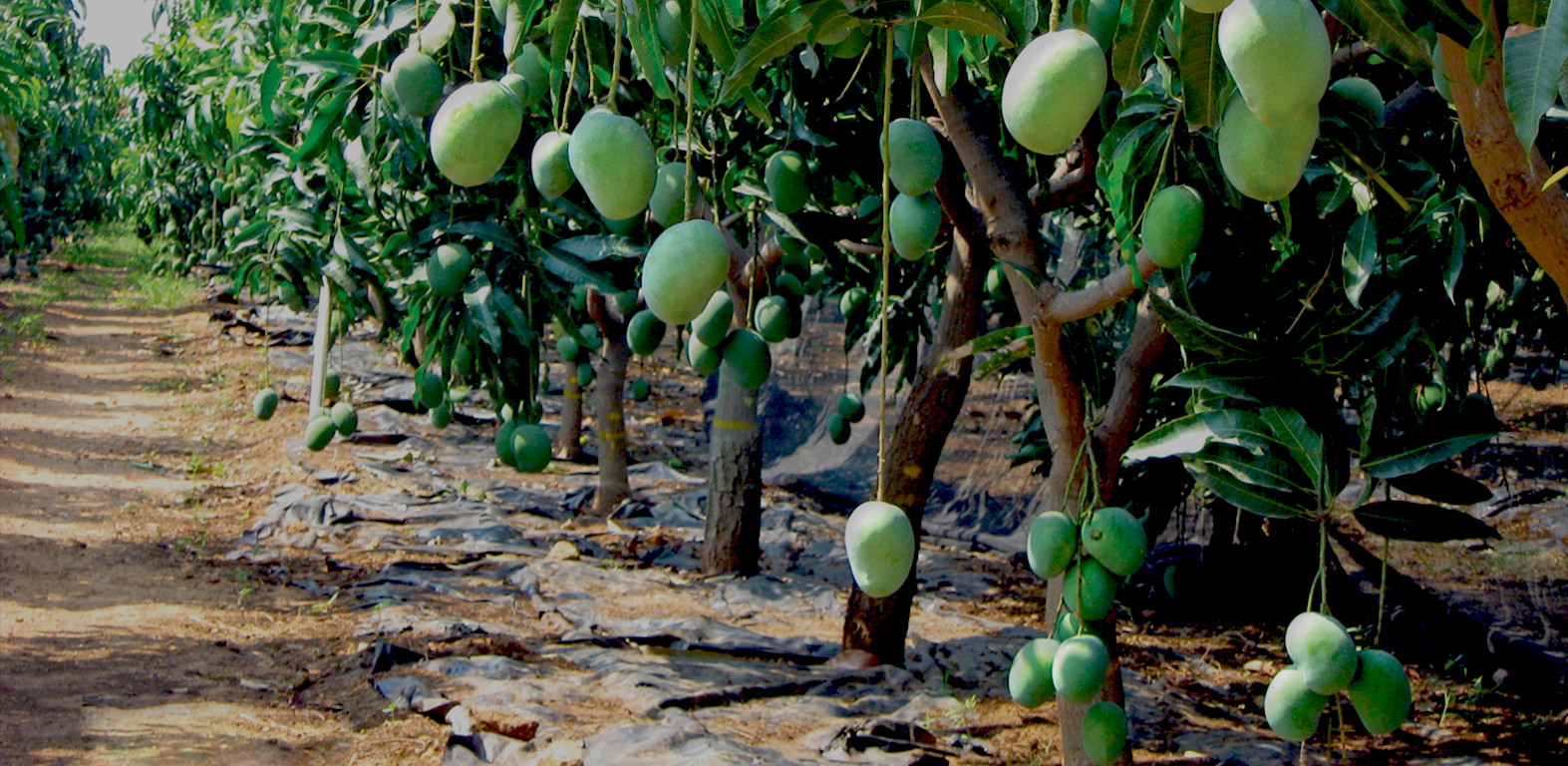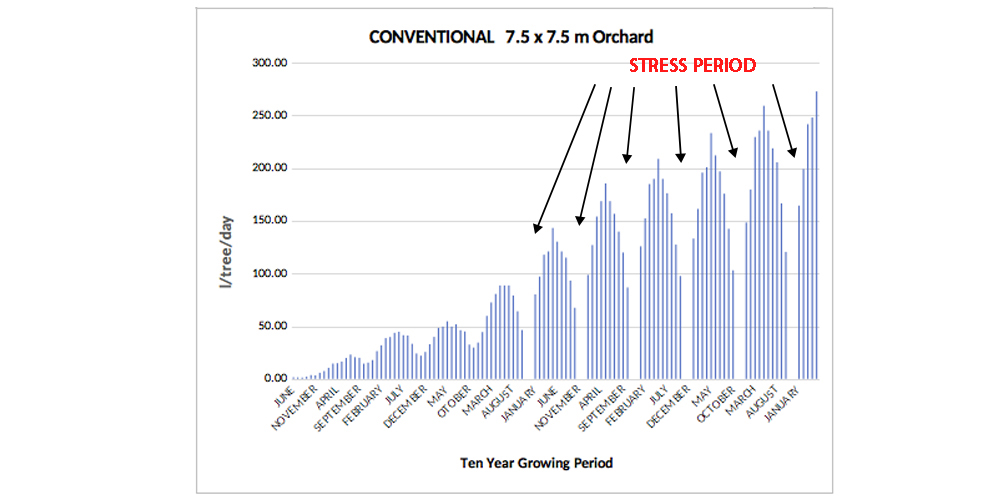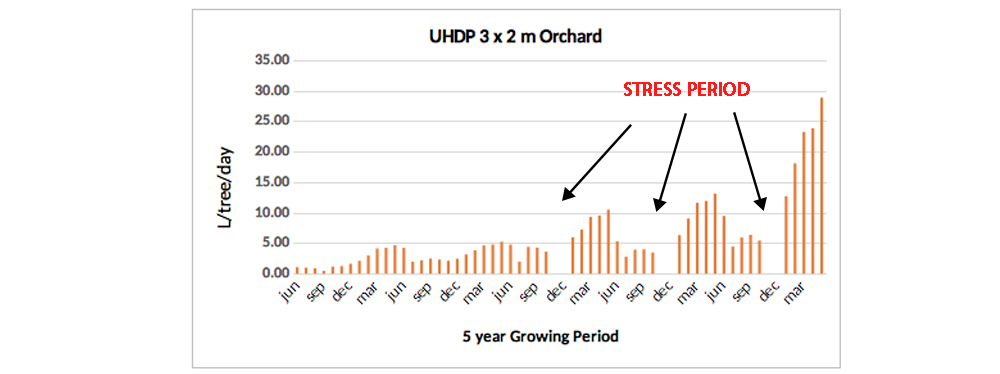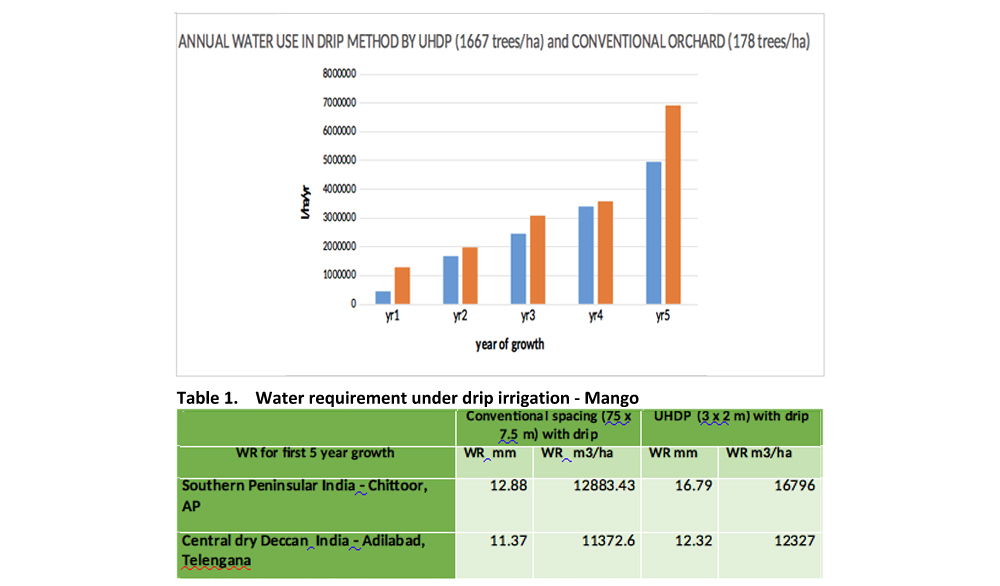Welcome to Jain Irrigation Systems Ltd.

Blog at Jains - HOW MUCH WATER DOES MY CROP NEED? Part II. Perennial crops, 1. Mango
I have written in this series so far only about annual (Banana, Sugarcane) or seasonal (Cotton, Tomato etc.) crops which have a definite single season growth period from germination to harvest (or physiological maturity).
Irrigation ’water need’ of perennials are specifically impacted by the fact that they repeat development processes every year. The water need varies with age (no of years), size (canopy cover) in a more dramatic way than they affect water need of annual or seasonal crops.
1. The major difference of perennials is that their life cycle repeats year after year producing fruits annually once or sometimes two times or continually once fruiting starts.
2. Many of them have an early life period of few years when they do not flower and fruit. We can call this pre-flowering stage.
3. Some species require a total dry period (however brief it is) every year prior to flowering.
4. Another factor that affect the water need is the management of their canopies by training and pruning (technology interventions).
5. Crop geometry (Row and tree spacing) also affects the water requirement.
Mango, a crop where all the above factors contribute to the water requirement is one of the best example to look at.
Mango is the "King of Fruits" and is the leading fruit crop of India. The mango tree is believed to have evolved as a canopy layer species in the tropical rainforest of south and southeast Asia. Mature specimens can attain a height of 30 m and can survive for more than 100 years. The root system consists of a long, vigorous taproot and abundant surface feeder roots. Both male and perfect flowers are found within a single inflorescence; the pistil aborts in male flowers. The ratio of male to perfect flowers is strongly influenced by environmental and cultural factors. It is believed that the flowers are cross-pollinated by flies.
India produces world’s highest tonnage of mango. It grows mango in 1,600,000 ha with a production of 10,800,000 t annually and an average productivity of 6750 kg/ha.
Mango is a perennial tree that may grow to a very large canopy if not restricted by annual pruning exercise. In commercial orchards the size of the canopy is maintained to enhance production and reduce overlap by adjacent canopies. The tree requires good penetration of sunlight into every section of the canopy.
Climatic Requirement of Mango
Mango is well adapted to tropical and subtropical climates. Though Mango can grow up to 1400 m altitude, commercial mango orchards are raised at places up to 600 m altitude. Its growth and fruiting are influenced by temperature, rainfall, wind velocity and altitude.
Annual mean temperature ranging from 21 oC to 27 oC is ideal for successful crop though it can grow in a temperature range of 5 to 44 oC. Higher temperature at fruit development enhances fruit size and quality.
Mango can perform well in areas with average annual rainfall of 250 mm to 2500 mm. However, frequent rains and high humidity will result in pests and diseases.
Because the rainfall events are very erratic and seasonal in India, regular and high tech mango cultivation aimed at higher yields require irrigation. Drip irrigation is ideal for mango orchards. Though conventional mango orchards planted at 10 x 10 m or 7.5 x 7.5 m may prefer under the tree Jets to wet the vast root spread (parallel to the canopy spread). But drip lines with drippers spaced at 50 or 60 cm is best suited for high density (HD) and Ultra High Density (UHDP) orchards.
Mango also requires a water stress (no irrigation) period of 50 to 60 days before flowering commences. This stress-shock is prescribed for flower induction and low volume to nil irrigation at advanced stage of maturity of fruits. These two requirements are very ably and precisely met when drip irrigation is adopted.
I have estimated the water need of Mango, in both conventional geometry (7.5 x 7.5 m; 174 trees/acre) and UHDP (3 x 2 m; 674 trees per acre). In the conventional orchard, first flowering occurs by the end of 5 th year, while in UHDP it occurs by the end of 3 rd year. No hard pruning or any pruning is done in the conventional system while a training is done at the 3 rd month of planting and pruning of the canopy to maintain the trees in relation to the space they are given is done every year in UHDP. These practices would affect the daily water requirement as they cause variation in the canopy (ground cover). The stress period of 60 days is considered to occur in the month of November and December (after observations of commencement of flowering in the recent years in India). It does not matter if this stress is implemented before or after, based on the experience of each location (flower commencement dates).
Water for Mango
Estimate of water use by the crop is becoming a necessity as the water availability is shrinking and it is known that Mango does not like excess soil moisture at any time of their growth. Growers are also looking for opportunities to improve water productivity, by conserving water or reducing its consumption. At this point one start asking "How much water does my crop need?
Moisture stress affects the growth and development of the plant especially during the post pruning vegetative and fruit growth stages. Drip irrigation is proved to be ideal for mango and the water requirement is precisely estimated.
Fig 1. Water requirement (ETP) estimated for drip method of irrigation of conventional mango orchard for 10 year growth period. Fruiting is expected at 5 th - 6 th year transition. (Chittoor dist., AP)

Fig 2. Water requirement (ETP) estimated for drip method of irrigation of UHDP mango orchard for 5 year growth period. Fruiting is expected at 3rd year. (Chittoor dist., AP)

Where does all the water go after one irrigates a crop field? Water moves out of the field in 7 different ways after an irrigation that floods the field: 1.Direct evaporation from the water surface, 2. Drift of water away from the field due to wind, 3. Transpiration through the body of the crop plant (Mainly thru leaves), 4. Evaporation from the wet ground exposed to the atmosphere, 5. Run off of water from the field, 6. Infiltration to lower soil strata and 7. Deep percolation to far deep soil profile.
Among these, the essential components of crop water use are only two: transpiration and soil surface evaporation. Hence water use by crop is referred to as ETP, Evapotranspiration. As the crop grows the surface evaporation gets reduced and when the soil surface is fully covered by the canopy (leaf and leaf bearing branches of the crop) there is only one dominant component of crop water use: Transpiration.
In precision irrigation, the water given should only be equivalent to ETP. The goal of perfect irrigation is to reduce the second component of water loss, surface evaporation. In conventional irrigation major part of water loss are in fact the rest of the 7 listed above.
When a farmer asks the question, HOW MUCH WATER DOES MY CROP NEED? The answer is the ETP (evaporation plus transpiration). Accordingly, I have estimated the water required for a good high productive crop. The difference among the regions is due to difference in evaporation rate during the growing season of the crop. The difference of ETP (drip) per ha between UHDP and conventional systems is influenced more by the number of trees/ha than by the area occupied by a tree. Therefore, though the water use per tree is lower in UHDP, consumption per ha is relatively high (See Fig 3 and Table 1).
Fig 3. Water consumption /year for drip method of irrigation of UHDP (3x 2 m) and conventional (7.5 x 7.5 m) mango orchards for 5 year growth period. Fruiting is occured at 3rd year in UHDP and is expected by 5 th year end in Conventional (Chittoor dist., AP)

Flow irrigation using basin system in conventional plantations consume 25,000 m3/ha/year, every year.
Precision Irrigation and fertigation for Mango is maintained by drip method of irrigation in both UHDP and conventional crop geometry.
Drip system for Mango
Inline drip line with 4 lph/ or 2.1 lph emitters spaced at 50 or 60 cm is found suitable for mango in UHDP system. The lateral spacing is 3 m in UHDP and 7.5 m in conventional plantation. In the conventional 7.5 x 7.5 m spacing of trees, in order to cover the entire canopy (plus 5 years onwards) two drip lines per row OR "under the tree Jets" are preferred. In UHDP, most of the medium soils need only a single drip line per row and in lighter soils two drip lines one on either side of the tree rows are recommended.
Under UHDP the yield of Mango (profuse fruiting varieties like Ratna , Totapuri) reaches 18-20 t/ha. At the same age the conventional spaced mango would begin to yield a paltry yield 3 or 4 t/ha only.
Applying water as per the estimates above is possible only through drip method of irrigation. In flow irrigation with basin system followed in many conventional plantations the water use is 25000 m3/ha in the whole season with very low efficiency.


